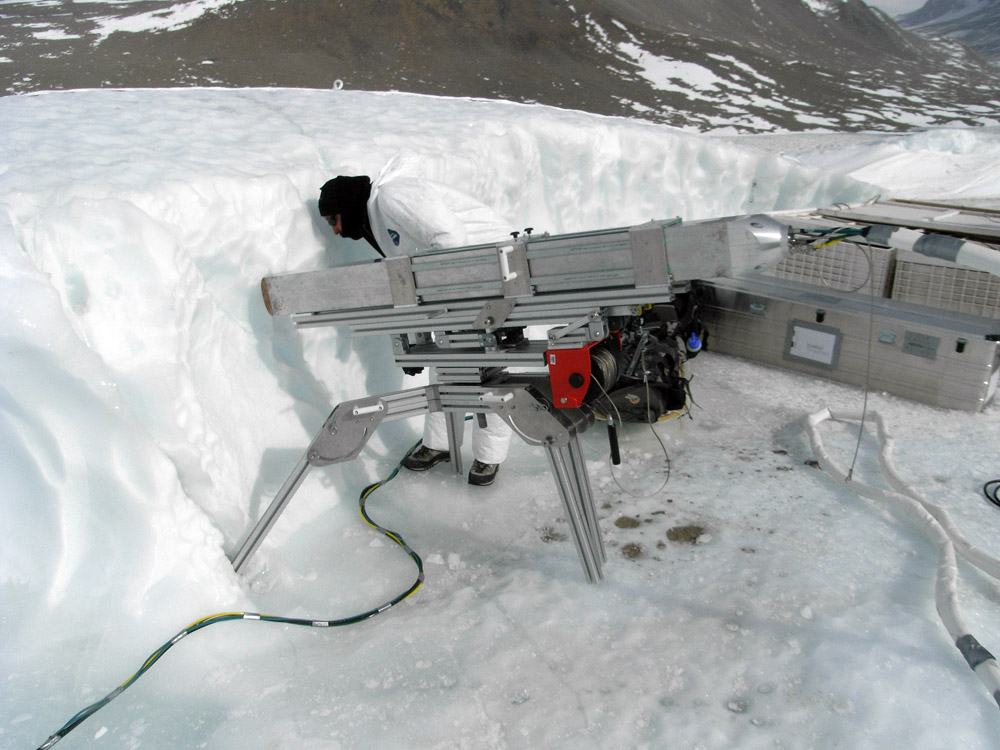|
Page 2/3 - Posted February 21, 2014
Researchers intend to penetrate subglacial conduit with maneuverable IceMole drillLife is already known to exist below Blood Falls. In 2009, Mikucki and colleagues published a paper in the prestigious journal Science that first suggested that microbes were dwelling in a highly saline reservoir below Taylor Glacier, which flows into Taylor Valley from East Antarctica. [See previous article — Ancient microbes: Unique community of bacteria found beneath Antarctic glacier.] Both are named after Griffith Taylor, the senior geologist on Capt. Robert F. Scott’s Terra Nova expedition, who first encountered the blood-like-stained feature in 1911. Taylor had assumed it was red algae. In reality, Blood Falls results from the discharge of iron-rich, saline liquid that percolates from a briny subglacial pool somewhere upstream of the massive river of ice. The liquid oxidizes rapidly at the surface, giving the ice its distinctive bloodstained coloration. “We’ve learned a lot about the brine,” Mikucki said. “It’s microbial-mediated process.” The light-starved environment means that the microbes are getting energy from another source other than photosynthesis, likely grinding away at the bedrock below the glacier and manipulating sulfur and iron compounds to survive. The reservoir itself appears to be marine in origin, seawater that was trapped by tectonic forces and later capped by ice. The water is nearly three times as salty as the ocean, and reaches the surface as a liquid through some sort of channel in the glacier. That subglacial conduit will be IceMole's eventual target. “We don’t know how [the brine] might change biologically and chemically, as it meanders out of the Falls,” Mikucki said. 
Photo Credit: Peter Rejcek
Canada Glacier in Taylor Valley, where the IceMole team tested the IceMole.
Mikucki’s team took the first steps toward answering that question among others during the 2013-14 Antarctic summer. She and the FH Aachen engineers put the IceMole through its paces on the nearby Canada Glacier. That included testing clean-access protocols to ensure samples returned from below Taylor Glacier aren’t contaminated. “It turns out [IceMole] was relatively easy to clean,” Mikucki said. “Sample return is still one of the huge challenges in the space industry, as well as the subglacial environment.” Blood Falls was adopted as an Antarctic Specially Protected Area IceMole’s maneuverability is also a big asset for subglacial research, according to Mikucki. “Blood Falls is amorphous. We don’t know exactly the shape and morphology of that crack,” she explained. “It’s a dynamic feature. We don’t know if it’s just dynamic at the surface or if it’s somewhat dynamic internally as well. It may not be a straight line. You may not be able to drill straight through. … There may be a need to drive it around.” FH Aachen engineer Clemens Espe explained that once IceMole reaches the crack or conduit that supplies the brine to the surface, the robotic probe has an internal pump that can send water to the surface. IceMole also has plastic bags within its body to store samples. Navigation deep in the ice is the big challenge. The IceMole uses a laser gyroscope to steer. Acoustic pingers on the surface measure the probe’s position independently using triangulation. An ultrasound sensor in the melting head should detect the crack or any obstacles in the way. “We accomplished what we needed to do here, which was demonstrating that the instrument could work in polar ice,” Mikucki said. “This is really a new step in ice-drilling technology.” |



For USAP Participants |
For The Public |
For Researchers and EducatorsContact UsNational Science FoundationOffice of Polar Programs Geosciences Directorate 2415 Eisenhower Avenue, Suite W7100 Alexandria, VA 22314 Sign up for the NSF Office of Polar Programs newsletter and events. Feedback Form |


